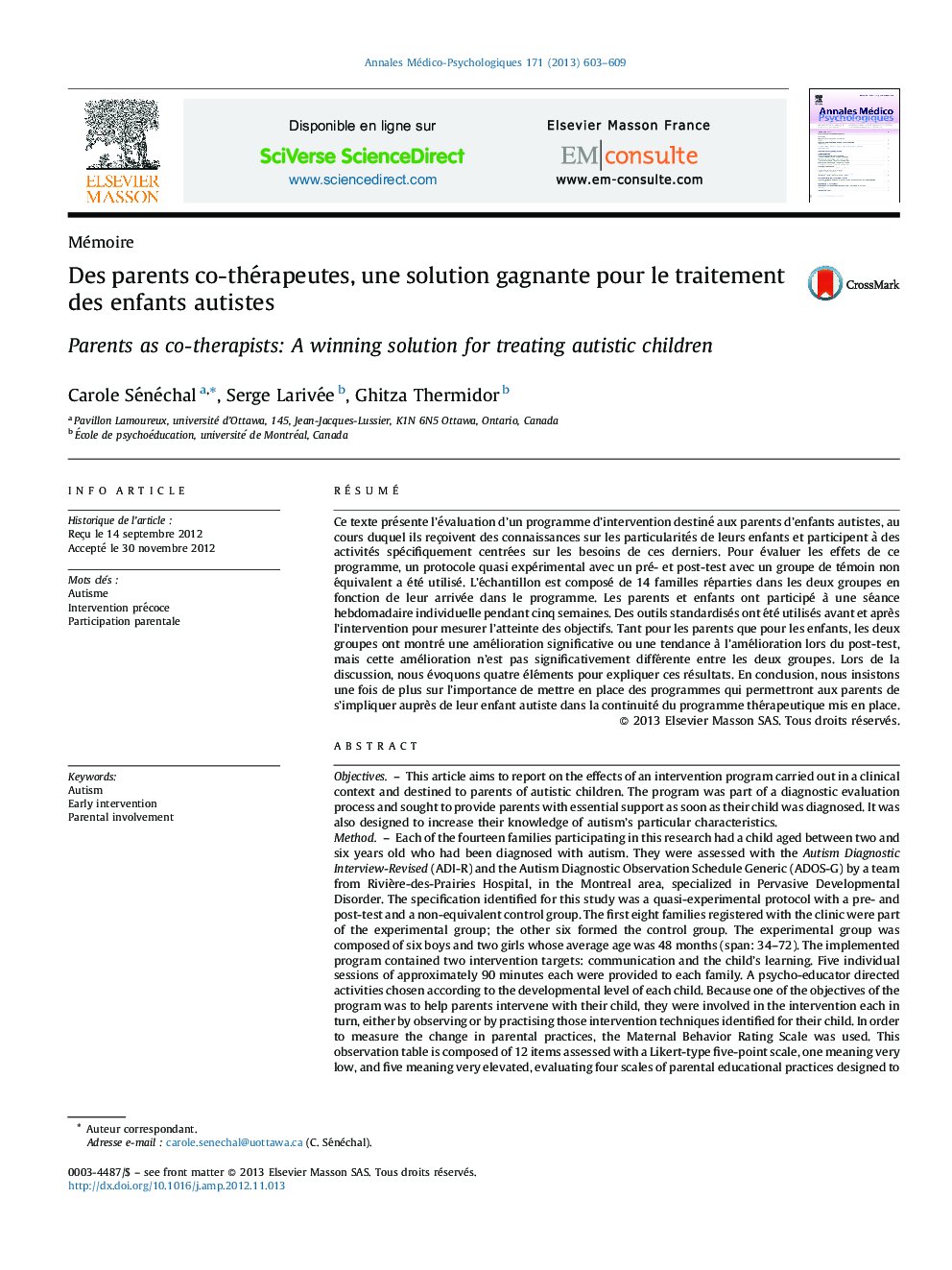| کد مقاله | کد نشریه | سال انتشار | مقاله انگلیسی | نسخه تمام متن |
|---|---|---|---|---|
| 314868 | 535476 | 2013 | 7 صفحه PDF | دانلود رایگان |

RésuméCe texte présente l’évaluation d’un programme d’intervention destiné aux parents d’enfants autistes, au cours duquel ils reçoivent des connaissances sur les particularités de leurs enfants et participent à des activités spécifiquement centrées sur les besoins de ces derniers. Pour évaluer les effets de ce programme, un protocole quasi expérimental avec un pré- et post-test avec un groupe de témoin non équivalent a été utilisé. L’échantillon est composé de 14 familles réparties dans les deux groupes en fonction de leur arrivée dans le programme. Les parents et enfants ont participé à une séance hebdomadaire individuelle pendant cinq semaines. Des outils standardisés ont été utilisés avant et après l’intervention pour mesurer l’atteinte des objectifs. Tant pour les parents que pour les enfants, les deux groupes ont montré une amélioration significative ou une tendance à l’amélioration lors du post-test, mais cette amélioration n’est pas significativement différente entre les deux groupes. Lors de la discussion, nous évoquons quatre éléments pour expliquer ces résultats. En conclusion, nous insistons une fois de plus sur l’importance de mettre en place des programmes qui permettront aux parents de s’impliquer auprès de leur enfant autiste dans la continuité du programme thérapeutique mis en place.
ObjectivesThis article aims to report on the effects of an intervention program carried out in a clinical context and destined to parents of autistic children. The program was part of a diagnostic evaluation process and sought to provide parents with essential support as soon as their child was diagnosed. It was also designed to increase their knowledge of autism's particular characteristics.MethodEach of the fourteen families participating in this research had a child aged between two and six years old who had been diagnosed with autism. They were assessed with the Autism Diagnostic Interview-Revised (ADI-R) and the Autism Diagnostic Observation Schedule Generic (ADOS-G) by a team from Rivière-des-Prairies Hospital, in the Montreal area, specialized in Pervasive Developmental Disorder. The specification identified for this study was a quasi-experimental protocol with a pre- and post-test and a non-equivalent control group. The first eight families registered with the clinic were part of the experimental group; the other six formed the control group. The experimental group was composed of six boys and two girls whose average age was 48 months (span: 34–72). The implemented program contained two intervention targets: communication and the child's learning. Five individual sessions of approximately 90 minutes each were provided to each family. A psycho-educator directed activities chosen according to the developmental level of each child. Because one of the objectives of the program was to help parents intervene with their child, they were involved in the intervention each in turn, either by observing or by practising those intervention techniques identified for their child. In order to measure the change in parental practices, the Maternal Behavior Rating Scale was used. This observation table is composed of 12 items assessed with a Likert-type five-point scale, one meaning very low, and five meaning very elevated, evaluating four scales of parental educational practices designed to improve children's development: the parent's response (three items), the parent's animation (five items), the parent's support with the task (two items) and his or her authority (two items). The program's impact with the child was assessed with the Child Behavior Rating Scale, an observation table comprised of two scales recognized as preconditions to children's development: attention (four items) and initiation (two items). These items were assessed by two observers with a Likert-type five-point scale, one meaning very low and five meaning very elevated. Inter-rater coefficients varied between 0.88 and 0.93.ResultsVariance analyses undertaken from the results obtained with the Maternal Behavior Rating Scales and the Child Behavior Rating Scales before and after the intervention showed that both groups improved but that this improvement did not vary significantly from one group to the other.ConclusionsFour elements may help explain the absence of significant results. Firstly, all children except one were recipients of other services during the intervention. Secondly, with regards to the objective of helping parents better understand their child's diagnostic, five 90-minute individual sessions appeared to be sufficient, but obviously that was not the case. Thirdly, there were difficulties with the recruitment and the sample's non-homogeneity. Fourthly, over and above their good psychometric qualities, the two instruments used were not sufficiently attuned to more subtle changes. Finally, we must insist on the importance, especially in human and social sciences, of publishing results considered as negative in as much as those results form an integral part of the scientific process.
Journal: Annales Médico-psychologiques, revue psychiatrique - Volume 171, Issue 9, November 2013, Pages 603–609